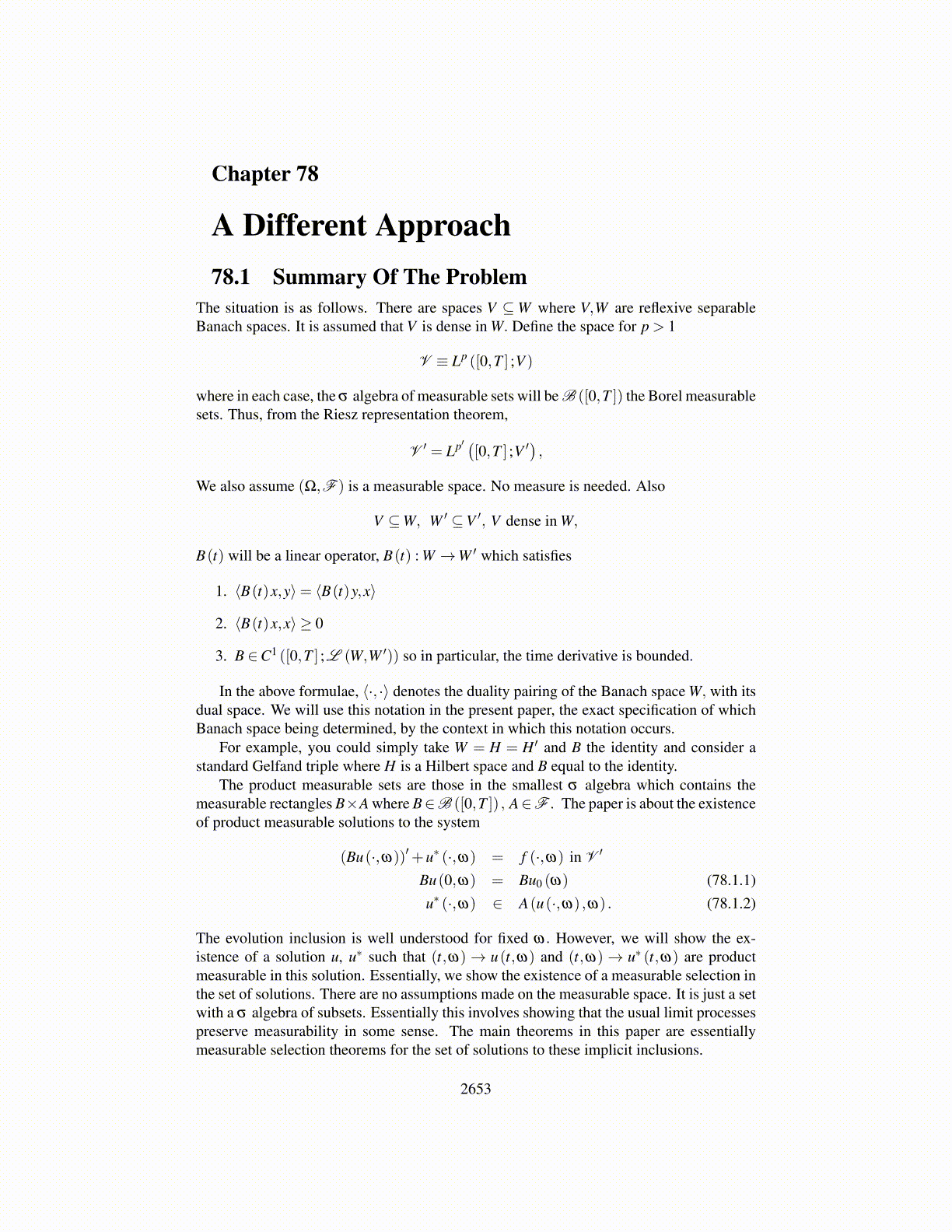
77.8. ADDING A QUASI-BOUNDED OPERATOR 2653
ω, limµ(ω)→0 uµ(ω) (·,ω) = ū(·,ω) weakly in V . However, from the above argument, foreach ω, there is a further subsequence, still denoted with subscript µ (ω) such that in V ′,
limµ(ω)→0
uµ(ω) (·,ω) = u(·,ω)
where u is a solution to the integral equation. Since u(·,ω) = ū(·,ω) in V it follows thatthese must be equal a.e. and hence (t,ω)→ u(t,ω) is product measurable. This proves thefollowing theorem.
Theorem 77.8.10 Suppose 77.8.73 - 77.8.78 and B as described above and u0 is F mea-surable. Also let G : D(G)⊆V →P (V ′) be maximal monotone and quasi-bounded.
Then, there exists a solution u of the integral equation
Bu(t,ω)+∫ t
0z(s,ω)ds+
∫ t
0g(s,ω)ds =
∫ t
0f (s,ω)ds+Bu0 (ω) ,
where (t,ω)→ u(t,ω) is product measurable (t,ω)→ z(t,ω) also. Moreover, for eachω , Bu(t,ω) = B(u(t,ω)) a.e. t and z(·,ω) ∈ A(u(·,ω) ,ω) , and g(·,ω) ∈G(u(·,ω)) foreach ω .
Note that in the case of most interest where you have a Gelfand triple and B is theidentity, the fundamental theorem of calculus implies easily that ω → z(s,ω)+g(s,ω) ismeasurable for a.e. s. One can also generalize to the following in which a measurableq(t,ω) is added.
Corollary 77.8.11 Suppose 77.8.73 - 77.8.78 and B as described above and u0 is F mea-surable. Also let G : D(G) ⊆ V → P (V ′) be maximal monotone and quasi-bounded.Let (t,ω) → q(t,ω) be product measurable into V and let t → q(t,ω) be continuous,q(0,ω) = 0. Then, there exists a solution u of the integral equation
Bu(t,ω)+∫ t
0z(s,ω)ds+
∫ t
0g(s,ω)ds =
∫ t
0f (s,ω)ds+Bu0 (ω)+Bq(t,ω) ,
where (t,ω)→ u(t,ω) ,(t,ω)→ z(t,ω) ,g(t,ω) are product measurable. Moreover, foreach ω , Bu(t,ω) = B(u(t,ω)) a.e. t and z(·,ω) ∈ A(u(·,ω) ,ω) for a.e. t, and g(·,ω) ∈G(u(·,ω)) for each ω .
Proof: Define a stopping time
τn (ω)≡ inf{t : q(t,ω)> n}
Then let Ã(·,ω) ≡ A(qτn (·,ω)+w,ω) . Then à satisfies the same properties as A and sothere exists a solution to the integral equation
Bwn (t,ω)+∫ t
0zn (s,ω)ds+
∫ t
0gn (s,ω)ds =
∫ t
0f (s,ω)ds+Bu0 (ω)
where wn,zn,gn are product measurable, zn (·,ω) ∈ Ã(wn (·,ω) ,ω) a.e. t. By continuityof t → q(t,ω) ,τn = ∞ for all n sufficiently large and so q(t,ω) = qτn (t,ω). As before,